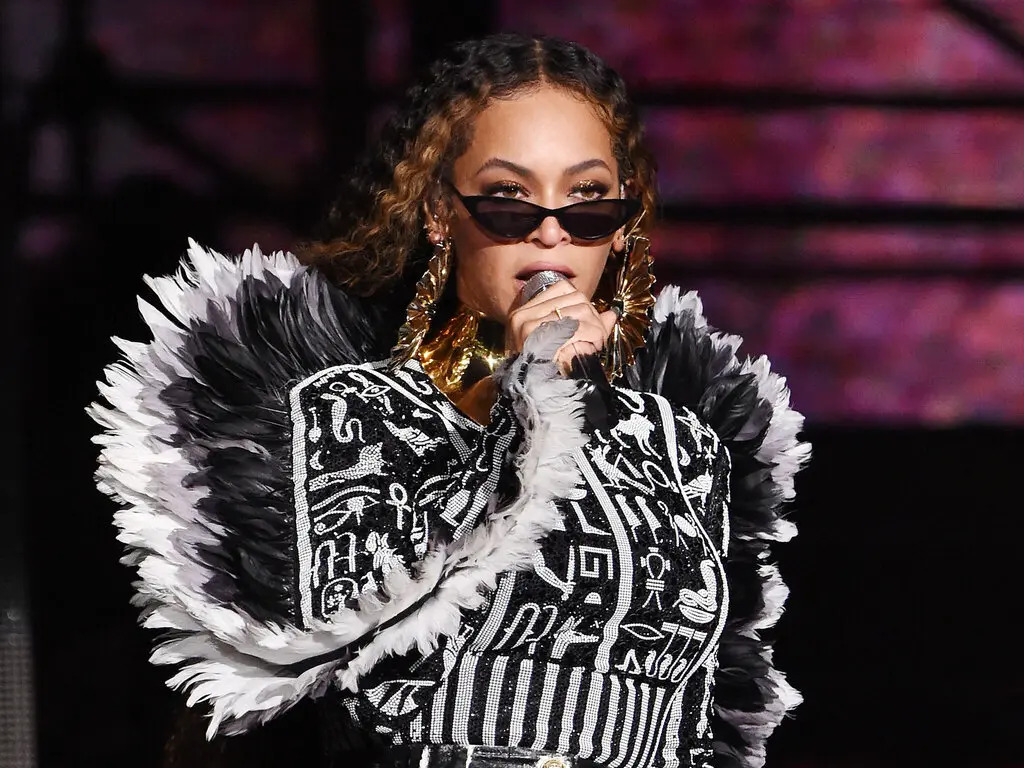
Much is made of pop star “eras” these days, but the term is deployed as a tool of marketing, not meaning. Rare is the artist who can sustain multiple visions and repeatedly regenerate. But different cultural and social moments have demanded different Beyoncés, and she has consistently delivered. At times she has been a singles powerhouse, dominating the radio and pop charts. At others, she has announced herself as a seismic cultural force, playing on a field much bigger than music. On Friday she will release “Renaissance,” her seventh solo studio album. Below, eight New York Times critics and reporters choose what they believe to be her definitive album so far, the one that reveals the most truth about the scope and shape of her career.Is Beyoncé’s Latest Album Rollout (Gasp!) Conventional?July 27, 2022
‘B’Day’ (2006)
Beyoncé’s second solo album opens with “Déjà Vu,” and “bass” is the first thing we hear her say. So up rumbles the most bootylicious bottom. The second is “hi-hat.” And a slapping sizzle ensues. But I don’t know who’s at the kit, ’cause that ain’t what no regular cymbals sound like when you slap ’em. These ones here? They make a sick drag. They double-dutchin’.
That’s the time signature for at least the first half of this album: two rope turners and a jumper. “B’Day” arrived in 2006 just before Labor Day. And the whole thing — minus two of the last three ballads — is wet with the nectar of a wrenched-open fire hydrant.
“Déjà Vu” spreads into “Get Me Bodied,” which hops to “Suga Mama” then “Upgrade U” and “Ring the Alarm,” which leads to “Kitty Kat,” “Freakum Dress” and “Green Light.” Different rooms on Single Ladies Night at the biggest club in Stankonia. It slinks and struts. This album’s the one that culminates with the ninth track (of an efficient 12): That would be “Irreplaceable,” the “Wanted Dead or Alive” of “better call Tyrone” balladry.
“B’Day” doesn’t have the split-persona nerve of “Sasha Fierce” or that damn-the-charts idiosyncrasy of “4,” the first of her masterwork trio. It’s a parade of bangers about lust and its discontents, about how to take a nightspot over with Naomi Campbell’s walk. Her singing hadn’t yet gone through the puberty of playing Etta James. And yes, Jay-Z’s two appearances still sound like a formula replicated rather than a partnership forged. And do I know why she’s been photographed for the cover to evoke Brigitte Bardot if Bardot missed the last train out of Stepford? I really don’t.
What’s essential about it, though, is its author’s determination to have it be more than some pop singer’s next album. Beyoncé angles for the synths and drum machines to frolic with all the horns, Latin percussion and credited use of a ney. She all but resorts to violence and makes funnies (“pat-pat-pat your weave, ladies”). I remember hearing these songs for the first time and feeling as slinky and swaggering as this music. I also remember laughing. With respect. I mean, she went and called the thing “B’Day,” like a star who knows she was born. WESLEY MORRIS
‘I Am … Sasha Fierce’ (2008)
Before Beyoncé’s third solo LP, she was a girl-group standout. She was a master of the cadences where early 2000s R&B met hip-hop. She was a sturdy practitioner of the ballad, the soulful throwback, the dancey throwdown. But on “I Am … Sasha Fierce,” she became something more significant: a character.
Sasha Fierce was the name of an alter ego Beyoncé created over the years “whenever I have to perform,” she told Oprah Winfrey in 2008. It was her stage persona; the fearless, brash pop queen in the leotard, not the demure mortal on the host’s couch, gamely discussing her work — something Beyoncé would stop doing once fierceness transformed from an onstage mood into her default public presentation. Beyoncé seizing control of how her music is released, commandeering a girl army in a dusty apocalyptic wasteland, leading a squadron of dancers on the Super Bowl halftime field, transforming a music festival into a personal showcase, redefining her relationship with her husband on a joint album, controlling her image on Instagram — all of that springs from the absorption of Sasha Fierce into Beyoncé.
The music on “I Am … Sasha Fierce” was divided in half: eight ballads where Beyoncé unfurled elegant, virtuosic vocals, and eight uptempos delivered with snarls and grit. Sasha Fierce’s arrival was cemented on “Single Ladies (Put a Ring on It),” where she became a defiant spokeswoman for the spurned. Gender dynamics dominated the album’s most interesting tracks, including “If I Were a Boy,” where Beyoncé imagined the freedom she’d enjoy if she’d been entitled to the casual power of manhood, and “Diva,” where she redefined a feminine archetype as a masculine, streetwise pose.
But the album’s true pivot point may have been “Video Phone,” an almost atonal, grindy track Beyoncé rereleased as a remix with Lady Gaga, then pop’s most adventurous star; Beyoncé repaid the favor with an appearance on “Telephone” that let her be astonishingly, gloriously weird. Over the past few years, they’ve nearly swapped careers: Gaga has become the traditionalist, and Beyoncé the explorer. CARYN GANZSign up for the Louder Newsletter Stay on top of the latest in pop and jazz with reviews, interviews, podcasts and more from The New York Times music critics. Get it sent to your inbox.
‘4’ (2011)
Even Beyoncé had to pull back and re-center before exploding outward again. In between the complementary bombast of “I Am … Sasha Fierce” and “Beyoncé,” following a split with her manager-father and something of a creative hiatus, came the relatively subdued “4,” the first album released via the singer’s all-purpose entertainment company, Parkwood.
That Beyoncé chose, in this moment of renewal and self-determination, to wrap herself in the warmth of traditional soul and R&B was telling, and it paid off in the strength of her vocal performances, which rank among her best even on the album’s inconsistent array of ballads. Opening the original track list with “1+1,” possibly her barest emotional showing, seemed at the time like a play for seriousness, and unlike most pop stars staring down their perceived frivolity, it actually worked: Even as “4” remains the least commercially successful of Beyoncé’s solo albums, it feels like the pivot moment in which she came to be perceived as an auteurist, capital-A album artist, timeless and often untouchable. Stripping down well can do that.
Yet “4” also contains some of the most enduringly crowd-pleasing Beyoncé singles (“Love on Top,” “Countdown,” “Party”), plus her best bonus track (“Schoolin’ Life”), with the production and writing duo The-Dream and Tricky Stewart, consistent collaborators throughout the singer’s various eras, operating at the height of their powers. (Even the album’s lead single, “Run the World (Girls),” which doesn’t quite fit and was originally tacked onto the end of the track list, provides the best peek at the self-titled moment to come.) Pure Beyoncé, tight at just 12 official tracks but with plenty of all of the things she does best, “4” is an amuse bouche and a palate cleanser that ends up being better than most meals. JOE COSCARELLI
‘Beyoncé’ (2013)
When a musician’s fifth album is self-titled, it can be a sign of empty gimmickry or a lack of ideas. But “Beyoncé” marked her full transformation into the star we have known ever since: an artist whose true medium is fame, who cannot be limited to any format, who bends the world to her will.
At midnight on Dec. 13, 2013, Beyoncé posted “Surprise!” on Instagram, and the album’s 14 songs and 17 videos appeared for sale on iTunes. The stealth release — back then, partly a defensive strategy against leaks — is what mostly captured public imagination. But in retrospect, “Beyoncé” comes across as a broader manifesto about Beyoncé as a performer and a human being. It’s all about containing multitudes, and looking fabulous doing so. Songs like “Flawless” and “Pretty Hurts” (“We shine the light on whatever’s worst”) position her as a paradox, both perfect and imperfect, a deity who is kinda-sorta relatable.
Yet “Beyoncé” also marked the point at which mere music seemed insufficient for her. Beyoncé’s true project was on a bigger canvas, one centered on her image and her potency as a 21st-century media celebrity. The music videos that were part of the original “visual album” — now best viewed as a YouTube playlist — are essential to the story she tells. That narrative touches on the meaning of feminism (with a place for lap dancing), monogamy and Black identity; the video for “Superpower” even includes a Black Lives Matter-style protest scene with Beyoncé in camouflage and fishnets.
Mostly, though, the story adds up to Beyoncé’s majesty, with music just one jewel in the crown. BEN SISARIO
‘Lemonade’ (2016)
On “Lemonade,” Beyoncé merged a message of solidarity with a cry from the heart. The second of Beyoncé’s visual albums, “Lemonade” mustered lavish musical and filmic resources to expand an individual story — the fury of a betrayed wife — toward a recognition of how many kinds of injustice, personal and historical, that women have endured, particularly Black women.
The songs easily stood up on their own, slipping sonic experimentation and an eerie sense of space into sturdy pop structures. Beyoncé both collaborated widely and drew samples from across genres and eras: Kendrick Lamar, the Weeknd, James Blake, the Yeah Yeah Yeahs, Led Zeppelin, Animal Collective. She hurled raspy imprecations in “Hurt Yourself” and let her voice break with tearful desperation and then find its own resolve in the hymnlike “Sandcastles.” She claimed Texas country with “Daddy Lessons,” electronica with “Sorry” and marching-band unity in “Freedom.”
The album’s lyrics continued Beyoncé’s career-long stance of self-determination, but they also admitted to pain and bewilderment. Heard as a whole, “Lemonade” created a narrative of one couple’s fracture, separation and, amazingly, reconciliation, with a postscript — “Formation” — that posited Beyoncé’s success as the spearhead of a movement.
Then the visual album multiplied the songs’ implications. Beyoncé recited poems by Warshan Shire that saw women’s pain as not only individual but archetypal. She showed images of women of all ages and multiple eras — in plantation dresses, African-style face paint, haute couture and streetwear — and of real parents mourning children shot by police. Onscreen, Beyoncé was singing not only for herself, but for all of them. JON PARELES
I know exactly where I was when “Lemonade” dropped: at home mourning Prince’s death by listening to the obscure and familiar that is his oeuvre. Then Beyoncé’s most personal album arrived as an offering to her audience and her ancestors, an otherworldly gift that crossed histories, geographies and genres to help us all heal.
She opened on a stage, then in a field while wearing a hoodie. With the haunting ballad “Pray You Catch Me” as its score, she was a stand-in for Trayvon Martin, tragically killed in Florida. And as her album’s tale unfolded, this insistence on not forgetting was underscored by the appearance of his mother, Sybrina Fulton; Eric Garner’s mother, Gwen Carr; and Michael Brown’s mother, Lezley McSpadden-Head; each holding photographs of their gone-to-soon sons. These were the album’s stakes — “Lemonade” was not about a woman scorned (though that might be there), but a work made in the struggle and for a people whose lives seem not to matter. So, yes, it is fair to say this was her movement album, but it is also her major album.
Beyoncé had been experimenting with the video form for a minute; her 2013 self-titled album was a mix of styles, personas and declarations. But on “Lemonade,” she was at her most liberated — beyond the eye of her father or the gaze of her husband — and in the company of other Black women and girls with whom she found solace and salvation. And if that weren’t enough, Beyoncé was also settling scores and swinging baseball bats.
To watch it for over an hour was to embark on an epic journey; to hear it was to witness her take on the American songbook. Her swift move from reggae (“Hold Up”) to rock (“Don’t Hurt Yourself”), from country (“Daddy Lessons”) to hip-hop (“Formation”), with so much soul and R&B in between (“Freedom,” anyone?) was not just a testament to her skill, but also her testifying about the innovative power of Black music and how it repeatedly makes American pop music, well, so popular. During that weekend in April 2016, Beyoncé not only gave us her genius, she moved a nation. SALAMISHAH TILLET
‘Homecoming: The Live Album’ (2019)
It’s not terribly controversial to call Beyoncé’s brilliant 2018 Coachella performance — excuse me, Beychella — one of the undisputed highlights in her career. So why does the 2019 live album “Homecoming” still feel strangely underrated? Even without the dazzling visuals, considered solely as a sonic document, the immaculately recorded “Homecoming” deserves to be mentioned alongside classics of the genre like the Who’s “Live at Leeds,” Sam Cooke’s “Live at the Harlem Square Club” and Talking Heads’ “Stop Making Sense.”
Across nearly two hours, “Homecoming” becomes something more than a souvenir of the impressively calisthenic Beyoncé concert experience. It also works remarkably well as an unbroken piece of music, an expertly arranged 40-song medley that finds common moods and grooves throughout Beyoncé’s deep catalog — thanks in large part to the unifying presence of a drum line and marching band, recalling those of historically Black colleges and universities — and makes the case for her discography not as a disparate collection of eras and aesthetics but a vast continuum containing some of the century’s most forward-thinking pop music.
A militantly commanding rendition of “Sorry” seamlessly shape-shifts into a slinky “Me, Myself and I”; “Don’t Hurt Yourself” segues into a transcendent version of its spiritual predecessor “I Care” (just in case Beyoncé needed to remind anyone that she’d been making scorched-earth breakup songs long before “Lemonade”); even her verse on the remix of J Balvin’s 2017 “Mi Gente” smash-cuts to her early, Sean Paul-featuring solo hit “Baby Boy,” subtly connecting the dots between the different decades of pop over which she’s reigned. By the time Beyoncé (and a crowd of about 100,000 screaming people) reaches the album’s pinnacle — an ecstatic mash-up of “Get Me Bodied” and “Single Ladies” — it’s hard to feel anything but sweat-drenched awe at the scope of what she’s just achieved. LINDSAY ZOLADZ
Destiny’s Child, ‘The Writing’s on the Wall’ (1999)
Slight cheat here, but hear me out. Before “The Writing’s on the Wall,” released in 1999, Destiny’s Child was a promising R&B girl group with strong gospel roots. Its relatively straightforward 1998 debut album was good, sometimes very good. But the shift on “The Writing’s on the Wall” is palpable. It’s a wildly playful album, full of risky production and arrangements — skittering aquatic beats, odd filigrees, punchy power harmonies. To evolve their sound, Beyoncé (and her groupmates) opted to work with pop and soul progressives including Missy Elliott, Kevin (She’kspere) Briggs, Kandi Burruss and Rodney (Darkchild) Jerkins, all of whom were at the height of their powers. “Bills, Bills, Bills” is dizzyingly complex, “Jumpin’, Jumpin’” is futuristically forceful and Beyoncé’s singing at the end of “Bug a Boo” is a soaring interjection of traditional glory into the modish present.
These collaborators used Destiny’s Child as a template for forward-thinking pop grounded in experimental soul music, and Beyoncé was paying close attention. Throughout her solo career, she’s excelled at finding ways of folding songwriting and production avantists into her vision, demonstrating a preternatural understanding of how unexpected gestures can deepen an artist’s vision, not distract from it. The long tail of that lesson stretches through her solo discography: “Upgrade U,” “Run the World (Girls),” “Partition,” “Get Me Bodied” and many, many more. JON CARAMANICA




